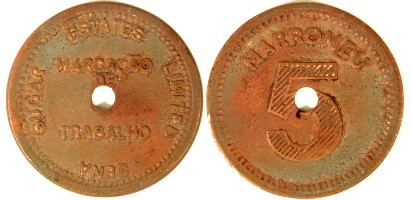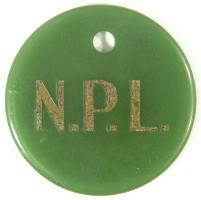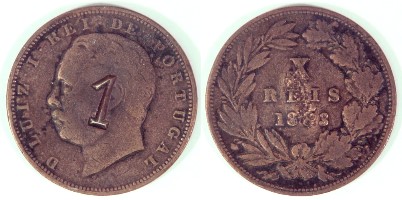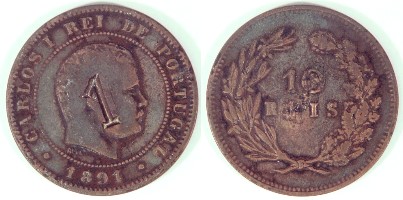
A Marromeu piece (not to scale)
See more at Mozambique - Page 1 of 2
I was recently given the
opportunity of studying a group of tokens that had been found in
Mozambique. As this was not a series with which I was familiar, it
became a challenge to learn what I could about these pieces, and I'm
happy to share my findings with you.
The main reference work, I
discovered, was a publication in Portuguese by Carlos Pascoal and Jamie
Salgado (1990) "Fichas Colonais Portuguesas" - Portuguese Colonial
Tokens. I will refer to this as P&S, and their listings are shown
as "M" numbers. Most of the tokens were also featured in Brian Hern's:
"Handbook on Southern African Tokens" (2004), and his references are
given as "Hern" numbers.
Sena Sugar Estates Limited was established in
1920,
upon the amalgamation of the various companies in which sugar magnate
John Peter Hornung played a leading role. Hornung was English and of
Hungarian descent. At its founding, the new company was wholly owned by
Hornung and his family. The company was based in Sena but had
operations in several other towns along the Zambezi. It was a
relatively large employer and was involved mainly in the cultivation
and processing of sugarcane. This company issued a larger number of
tokens, and in greater numbers, than any of the other issuers. Chances
are that if you have an old Mozambican token or have handled one, it
will have been from the Sena Sugar Estates. P&S put the tokens of
this issuer into three groups:- (A) the Luabo issues, (B) the Marromeu
issues and (C) those issues with no indication of region. P&S also
detail how the many tokens had different uses, namely to mark tasks,
designate work, pay for food, etc.

A Marromeu piece (not to scale)
This Marromeu piece has on its obverse, three
central lines “MARCAÇÃO” / “DE” / “TRABALHO”
(meaning “marking of work”), surrounded by the company name “SENA” /
“SUGAR” / “ESTATES” / “LIMITED”, all within a beaded border. The
reverse has a large shaded “5” with “MARROMEU” above, all within a
toothed border. The piece has a small central hole (apparently as
punched after striking), an overall diameter of 26.2 mm and mass of
6.19 grams. It is made from Bronze, has a plain edge and is listed as
M111 / Hern-538a.

A blank green triangular piece (not to scale)
This blank green piece was with the group of
tokens sourced in Mozambique and even though neither of the references
gives it a mention, it was likely issued by Sena Sugar Estates Limited.
The piece is made from moulded vulcanized rubber; it has a height of
34.5 mm and a central hole of diameter of 4.85mm. This piece is rather
similar to the piece listed by P&S as M104. That piece is of the
same colour, material and shape; it also has a similar hole. However
M104 is larger, with a height of 43mm and it has, on one side only, an
incuse legend “S S E LTD” and “LUABO” curved around the central hole.
There are quite a number of other types of Sena
Sugar Estates
Limited tokens – there are some that include a small array of punched
holes, some that are Brass, some are counter-stamped old Portuguese
bronze coins and others.
“João Ferreira dos Santos” was another trading company issuing
tokens in Mozambique. The company was established in 1897 and in more
recent times it is known as one of Mozambique's largest private
agricultural groups. They continue to be involved, on an international
scale, with products such as tobacco, tea, sisal and cotton.

A large JFS piece (not to scale)
This large, round, uniface “JFS” piece has a
diameter of 39.2mm,
mass 12.67 grams, is made from Brass and features large outlined
letters “JFS” with textured shading, a rim and a beaded border. The
piece has obviously been struck with a die just as a coin would be. The
references list this piece as M29 / Hern-304b and also list similar
pieces with diameters of 25mm and 51mm.

A triangular JFS piece (not to scale)
This holed, triangular, uniface “JFS” piece has a
height of 27.5mm, a central hole with diameter 3.5mm, a mass of 3.05
grams and is made from Brass. The two lined, incuse stamped legend
reads “JFS” / “MOÇAMBIQUE”. This piece is listed as M33 /
Hern-304f and with a height of 30mm (a slight cataloguing error
perhaps). Two other pieces of this style are also listed; one is round
(diameter 26mm) and holed and the other is square (26mm by 26mm) and
holed.
The two "JFS" pieces illustrated here are
examples of two of the three basic types known for this issuer. Pieces
of the third type listed in the references are said to be copper,
diameter 23mm, round with central hole and with neither rim nor legend
- just an outer serrated circle. According to P&S, it is believed
that these tokens were used as labour tokens for dock-workers on the
Island of Mozambique and that some of them may date back to the 19th
century. Further, the different shapes were used to distinguish
different activities as well as different locations (those being Lumbo,
Lunga, Mossuril, Saua Saija and Ilha de Mocambique). It is also stated
that in 1926 this company owned stores in Mocambique, Memba, Angoche
and Ibo – this would suggest retail stores for their various products.

An Empresa Dos Tabacos Da Beira Ltda 3 piece (not to
scale)

Empresa Dos Tabacos Da Beira Ltda 12 piece (not to
scale)
These two similar pieces were issued in the name of “EMPRESA DOS TABACOS DA BEIRA LTDA”. This name appears on the obverse of each piece, around a large, central “3” on the smaller piece and around a large, central “12” on the larger piece. The issuer’s Portuguese name translates as “Beira Tobacco Enterprise Ltd”. The obverses also feature a pearled border. The reverse, common to each piece has “MANGA” horizontally and “TABACOS” vertically, such that the first “A” in “MANGA” is used as the second “A” in “TABACOS”.
The amounts indicated on these pieces i.e. 3 and
12, are unlikely to be amounts of money, as normal amounts of money in
a decimal system would be such as 5 and 10. Perhaps the two amounts
each represent an amount of work done or product produced. Manga is in
District Beira and Beira is the country’s second largest city.
The “3” type has a diameter of 24.25mm and a mass
of 2.44 grams; it is listed as M137 / Hern-188a. The “12” type has a
diameter of 30.7mm and a mass of 3.87 grams; is listed as M138 /
Hern-188b. Both pieces are of Aluminium and have a crudely milled edge.
P&S state that these tokens were made in England but no further
details are given.

A Green N.P.L. piece (not to scale)
This piece features nothing but three initials –
“N.P.L.”. The
fading, gold-coloured incuse lettering is on just one side, the other
side of the piece is blank. The token is made from green Bakelite, has
a diameter of 25.5mm, mass 1.17 grams and a hole near to the top as if
for storing on a hanger. “N.P.L.” was Namagoa Plantations Ltd.,
District Quelimane. This piece is listed as M71 / Hern-378b. Pieces of
the same size and design are also listed made from pink Bakelite and
from grey Bakelite.
According to P&S – “This company was founded
in 1928 after the
dissolution of the Empresa Agricola de Lugela (Lugela Agricultural
Enterprise) and engaged only in sisal cultivation in the Mocuba region.
It was dissolved in 1969 when its plantations were sold to the
Companhis do Algodao de Mocambique (Mozambique Cotton Company). The
tokens were issued to the local labour force and were in use between
1928 and 1940.”

Luis I Ten Reis counter-stamped “1” (not to scale)

Carlos I Ten Reis counter-stamped “1” (not to scale)
These two Portuguese coins are each
counter-stamped “1” on their obverse. These coins are a 10 Reis dated
1883 of type KM-526 (the type of 1882 to 1886, portraying Luis I) and
10 Reis dated 1891 of type KM-532, (the type of 1891 to 1892,
portraying Carlos I). These two counter-stamped types are referred to
as M143 / Hern-298d and M145 / Hern-298b respectively. This
counter-stamp is known not only on dates of these two 10 Reis types but
also on the similar Portugal 20 Reis types KM-527 (the type of 1882 to
1886) and KM-533 (the type of 1891 to 1892). Those two are referred to
as M144 / Hern-298c and M146 / Hern-298a respectively.
It is stated in P&S that these tokens have been attributed to “Missão Católica de Jungamo” – the Catholic Mission at Jungamo in District Inhambane. These are the only tokens known from this district. Around this time education in Mozambique was mainly in the hands of the Roman Catholic missionaries. Portuguese Catholic missionaries had first taken Roman Catholicism to Mozambique in the sixteenth century.

Casino Belo 100 (not to scale)
This piece features intertwined “C” and “B” on
the obverse and “100” on the reverse. The legends are all horizontally
shaded. The piece is Brass, has diameter 22.5mm, mass 3.52 grams, plain
edge, medallic alignment. It is listed as being from Casino Belo,
District Lourenço Marques, M152. Another type, M151, is the same
except that it has coin alignment. (Both varieties are listed as
Hern-50c.) The other pieces listed for this casino are a “200” and a
“500”.

A Restaurante Oriental piece (not to scale)
This uniface piece of green plastic, features
nothing but a white, incuse, two line legend “R. O.” / “10$00”. The
piece has a diameter of 24.6mm and a mass of 1.58 grams. The
denomination is 10 Escudos, “10$00” being exactly how that denomination
appeared on Mozambique’s coins of 10 Escudos back then. This piece is
attributed to Restaurante Oriental, Lourenço Marques and
numbered M178 / Hern-406a. Other similar pieces listed are of 0$50,
1$00, 2$50 and 5$00, each with different colouring and with
denominations per the coinage. The city of Lourenço Marques was,
at that time, the name of Mozambique’s capital city. As a result of
independence, this Portuguese name was changed in 1976, to the current
name of Maputo.
According to P&S, “This restaurant was
located in Rua Consiglieri Peichoto. It seems that the shortage
of small change from 1971 onwards caused difficulties which the owners
tried to solve by issuing plastic tokens. These were used in-house
between the waiters and the cashier.”
This interesting group of tokens was kindly
submitted by Mr. Hilmar J. Herzberg who came across them during 2006.
Should any readers be able to add to the background story of any of
these pieces, then I would be very interested to hear from you. As with
any tokens, so much interest centres on how, when and where they were
used. With the passing years, unless recorded, this vital information
is often lost to future generations. Any additional snippets of
information we can glean on the issue or the issuers add to the
fascination of the story these pieces have to tell.
See more at Mozambique
- Page 1 of 2